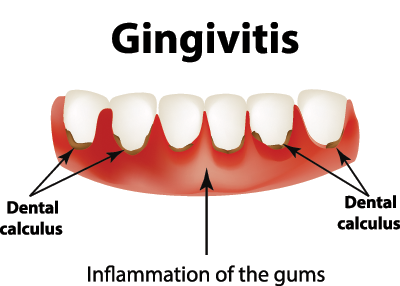I’m not a dentist, so sometimes my patients are surprised when I tell them I want to look at their teeth and gums.
Here’s why I do it…
Your mouth is an early warning system for serious conditions throughout your body. Whatever is going on with your oral health gives me a pretty good idea of what’s going on with all your major organs and systems.
It makes sense because everything in your body is connected biologically. And your mouth is the gateway to the rest of your body. It’s also home to around 100 billion bacteria.
Most dentists are concerned when those bacteria cause tooth decay and gum disease. But they’re missing the bigger picture. They don’t realize what they’re REALLY looking at.
The same bacteria in your mouth can travel to every part of your body. They cause inflammation. Left unchecked, that can lead to arthritis, nervous system disorders, cancer and more.

One of the biggest threats is to your heart. And it can all start with simple tooth plaque. As plaque builds up on teeth it creates a breeding ground for bacteria. The bacteria trigger inflammation. That leads to red, swollen, bleeding gums — a condition called gingivitis.
Left untreated, gingivitis can turn into periodontal disease. The gums pull back from the root of the tooth. Infection attacks the tissue that holds the tooth to the jawbone. Teeth start to come loose and fall out.
But it’s even worse. You see, when gum tissue breaks down, bacteria start seeping into your bloodstream. These microbes set your immune system on high alert. The blood vessels become inflamed. Bacteria can combine with platelets to create blockages and blood clots. If these reach the heart, they can cause heart attacks even in people who are otherwise fit and
healthy.
The
Dental Longitudinal Study followed 1,147 people for 18 years. Those with severe gum disease had a 150% greater risk of heart disease. They also had twice as many fatal heart attacks as the control group.1In other words, if you have gum disease you are more likely to have a heart attack.
Here’s What I Suggest…
Daily brushing and flossing aren’t enough to stop gingivitis from becoming a serious chronic disease. Here are three things I suggest to my patients to help keep their mouths and the rest of their body healthy:
1. Try Coconut Oil Pulling. I first learned about oil pulling nearly 20 years ago when I spent a month in India studying Ayurvedic medicine. In India, they call it “kavala graham.” And Ayurvedic practitioners have been using the ancient detox practice for more than 3,000 years.
It’s a simple process of swishing a tablespoon of oil in your mouth. The swishing pulls toxins out of teeth and tissues. And the oil leaves a film on the surface of the teeth and gums to help prevent plaque and bacteria from sticking.2
In a recent study from Nigeria, researchers tested coconut oil pulling on 60 young people with gingivitis caused by plaque. Within just seven days, both plaque and gingivitis levels dropped.3
All you do is gently swish one tablespoon of coconut oil in your mouth and between your teeth for 10 to 20 minutes. Don’t swallow. Spit the used oil out into the trash or a jar — not the sink. It will clog your plumbing. Rinse your mouth and brush your teeth as normal.
Aim for doing this three or four times a week. Do it right after you get up in the morning and before you eat or drink anything. Lots of my patients do it in the shower. You should notice a difference in your teeth and gums in a week or so.
2. Drink a Cup of “Mary Bush” Tea. My herbalist friend Ivey Harris introduced me to what she called “mary bush” in Jamaica. Here in the States we know it as balsam (Ocimum gratissimum). Studies show it helps protect your teeth and gums when you drink it in tea or rinse your mouth with it. It can reduce plaque and gingivitis.4
To make balsam tea, add 1 ounce fresh or ½ ounce dried balsam leaves and flowers to 1 ½ pints of boiling water. You can get the dried leaves at specialty stores and online. They may be sold as “Vana Tulsi.” Steep fresh leaves for 5 minutes or dried leaves for 15 minutes. Drink one cup three times a day. If you have sore gums, you should feel relief starting
with the first cup.
3. Boost Immunity with Coenzyme Q10. Studies show people with gingivitis and periodontal disease have a deficiency of CoQ10. 5 In one double-blind trial, patients took 50 to 75 mg per day of CoQ10. It stopped gum disease very quickly — sometimes within just a few days.
Look for the more powerful ubiquinol form of CoQ10. Take at least 60 mg per day to prevent gum disease. But if you already have gum disease or an infection, take 100 mg twice a day. I’ve seen it help repair visibly damaged gum tissue.
To Your Good Health,
![]()
Al Sears, MD, CNS
1 Arbes SJ Jr., Slade GD, Beck JD. “Association Between Extent of Periodontal Attachment Loss and Self-reported History of Heart Attack: An Analysis of NHANES III Data.” J. Dent. Res. 78[12]:1777-82, 1999.
2 Asokan S, Emmadi P, Chamundeswari R. “Effect of oil pulling on plaque induced gingivitis: A randomized, controlled, triple-blind study.” Indian J Dent Res. 2009;20:47–51.
3 Peedikayil FC, Sreenivasan P, Narayanan A. “Effect of coconut oil in plaque related gingivitis — A preliminary report.” Nigerian Medical Journal : Journal of the Nigeria Medical Association. 2015;56(2):143-147.
4 Pereira S, de Oliveira J, Angelo K, et al. “Clinical effect of a mouth rinse containing Ocimum gratissimum on plaque and gingivitis control.” J Contemp Dent Pract. 2011;12(5):350-5.
5 Littarru GP, Nakamura R, Ho L, Folkers K, Kuzell WC. “Deficiency of coenzyme Q10 in gingival tissue from patients with periodontal disease.” Proc Nat Acad Sci USA. 1971;68:2332–5.

